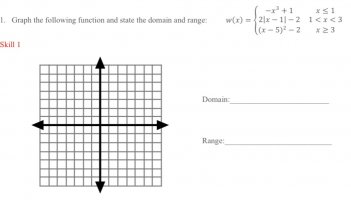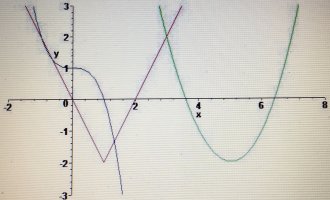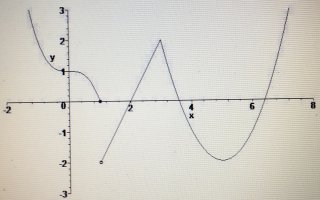The Velociraptors
New member
- Joined
- Jul 16, 2020
- Messages
- 48
This was on a friend’s precalculus packet:
 What I initially thought to do was substitute the restriction’s number into the respective equation, but my final graphed piecewise didn’t match the key. For example, for the first equation, I substituted 1 like this: (-1)^3+1 and got the coordinate (1,0). Then I followed the restriction, put an open circle on the point (1,0) and and arrow pointing to everything on the left of (1,0). I did the same thing for other equations, substituted the restriction number and got the coordinate. But since the key did not match this, I had a thought that my process doesn’t work for certain functions. So should I make multiple tables instead? (Even though I made a table, my final product didn’t match the key still, so maybe it’s an error on my part). For example, for the first equation, should I pick x values less than 1 after I get (1,0) and place the open circle there? Then for those values less than 1, do I substitute it back into the equation? For example, if I pick x value -1, do I substitute it like this: -(-1)^3+1 to get the y-value? Does anyone have a better approach to this? And if possible, can you direct me towards a good resource?
What I initially thought to do was substitute the restriction’s number into the respective equation, but my final graphed piecewise didn’t match the key. For example, for the first equation, I substituted 1 like this: (-1)^3+1 and got the coordinate (1,0). Then I followed the restriction, put an open circle on the point (1,0) and and arrow pointing to everything on the left of (1,0). I did the same thing for other equations, substituted the restriction number and got the coordinate. But since the key did not match this, I had a thought that my process doesn’t work for certain functions. So should I make multiple tables instead? (Even though I made a table, my final product didn’t match the key still, so maybe it’s an error on my part). For example, for the first equation, should I pick x values less than 1 after I get (1,0) and place the open circle there? Then for those values less than 1, do I substitute it back into the equation? For example, if I pick x value -1, do I substitute it like this: -(-1)^3+1 to get the y-value? Does anyone have a better approach to this? And if possible, can you direct me towards a good resource?
 What I initially thought to do was substitute the restriction’s number into the respective equation, but my final graphed piecewise didn’t match the key. For example, for the first equation, I substituted 1 like this: (-1)^3+1 and got the coordinate (1,0). Then I followed the restriction, put an open circle on the point (1,0) and and arrow pointing to everything on the left of (1,0). I did the same thing for other equations, substituted the restriction number and got the coordinate. But since the key did not match this, I had a thought that my process doesn’t work for certain functions. So should I make multiple tables instead? (Even though I made a table, my final product didn’t match the key still, so maybe it’s an error on my part). For example, for the first equation, should I pick x values less than 1 after I get (1,0) and place the open circle there? Then for those values less than 1, do I substitute it back into the equation? For example, if I pick x value -1, do I substitute it like this: -(-1)^3+1 to get the y-value? Does anyone have a better approach to this? And if possible, can you direct me towards a good resource?
What I initially thought to do was substitute the restriction’s number into the respective equation, but my final graphed piecewise didn’t match the key. For example, for the first equation, I substituted 1 like this: (-1)^3+1 and got the coordinate (1,0). Then I followed the restriction, put an open circle on the point (1,0) and and arrow pointing to everything on the left of (1,0). I did the same thing for other equations, substituted the restriction number and got the coordinate. But since the key did not match this, I had a thought that my process doesn’t work for certain functions. So should I make multiple tables instead? (Even though I made a table, my final product didn’t match the key still, so maybe it’s an error on my part). For example, for the first equation, should I pick x values less than 1 after I get (1,0) and place the open circle there? Then for those values less than 1, do I substitute it back into the equation? For example, if I pick x value -1, do I substitute it like this: -(-1)^3+1 to get the y-value? Does anyone have a better approach to this? And if possible, can you direct me towards a good resource?

